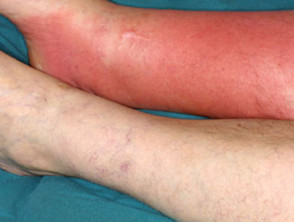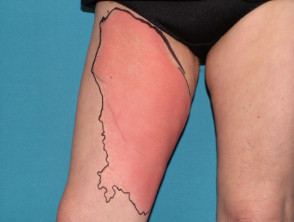What is cellulitis?
Cellulitis is a common bacterial skin infection of the lower dermis and subcutaneous tissue. It results in a localised area of red, painful, swollen skin, and systemic symptoms. Left untreated, cellulitis can be life-threatening.
Similar symptoms are experienced with the more superficial infection, erysipelas, so cellulitis and erysipelas are often considered together.
Cellulitis
Who gets cellulitis?
Cellulitis affects people of all ages and races.
Risk factors for cellulitis include:
- Previous episode(s) of cellulitis
- Fissuring of toes or heels, eg due to athlete's foot, tinea pedis or cracked heels
- Venous disease, eg gravitational eczema, leg ulceration, and/or lymphoedema
- Current or prior injury, eg trauma, surgical wounds, radiotherapy, IV drug use
- Immunodeficiency, eg human immunodeficiency virus infection (HIV)
- Immune suppressive medications
- Diabetes
- Chronic kidney disease
- Chronic liver disease
- Obesity
- Pregnancy
- Alcoholism
Many people falsely attribute an episode of cellulitis to an unseen spider bite. Documented spider bites have not led to cellulitis.
What causes cellulitis?
The most common bacteria causing cellulitis are Streptococcus pyogenes (two-thirds of cases) and Staphylococcus aureus (one third). Rare causes of cellulitis include:
- Pseudomonas aeruginosa, usually in a puncture wound of foot or hand
- Haemophilus influenzae, in children with facial cellulitis
- Anaerobes, Eikenella, Streptococcus viridans, due to human bite
- Pasteurella multocida, due to cat or dog bite
- Vibrio vulnificus, due to saltwater exposure, eg coral injury
- Aeromonas hydrophila from fresh or saltwater exposure, eg following leech bites
- Erysipelothrix (erysipeloid), in butchers.
Other forms of skin injury that may increase bacterial exposure and cellulitis infection include surgical wounds and insect bites.
Cellulitis is generally not contagious as it affects the deeper layers of the skin.
What are the clinical features of cellulitis?
Cellulitis can affect any site, but most often affects the limbs
- It is usually unilateral; a bilateral disease is more often due to another condition
- It can occur by itself or complicate an underlying skin condition or wound.
The first sign of the illness is often feeling unwell, with fever, chills and shakes (rigors). This is due to bacteria in the bloodstream (bacteraemia). Systemic symptoms are soon followed by the development of a localised area of painful, red, swollen skin. Other signs include:
- Dimpled skin (peau d’orange)
- Warmth
- Blistering
- Erosions and ulceration
- Abscess formation
- Purpura: petechiae, ecchymoses, or haemorrhagic bullae
Cellulitis may be associated with lymphangitis and lymphadenitis, which are due to bacteria within lymph vessels and local lymph glands. A red line tracks from the site of infection to nearby tender, swollen lymph glands.
After successful treatment, the skin may flake or peel off as it heals. This can be itchy.
What are the complications of cellulitis?
Severe or rapidly progressive cellulitis may lead to complications that require prompt treatment:
- Necrotising fasciitis (a more serious soft tissue infection recognised by severe pain, skin pallor, loss of sensation, purpura, ulceration and necrosis)
- Gas gangrene
- Severe sepsis (blood poisoning)
- Infection of other organs, eg pneumonia, osteomyelitis, meningitis
- Endocarditis (heart valve infection).
Sepsis is recognised by fever, malaise, loss of appetite, nausea, lethargy, headache, aching muscles and joints. The serious infection leads to hypotension (low blood pressure, collapse), reduced capillary circulation, heart failure, diarrhoea, gastrointestinal bleeding, renal failure and loss of consciousness.
How is the diagnosis of cellulitis made?
The diagnosis of cellulitis is primarily based on clinical features including a physical exam. Investigations may reveal:
- Leukocytosis (raised white cell count).
- Elevated C-reactive protein (CRP)
- The causative organism, on the culture of blood or of pustules, crusts, erosions or wound.
Imaging may be performed. For example:
- Chest X-ray in case of heart failure or pneumonia
- Doppler ultrasound to look for blood clots (deep vein thrombosis)
- MRI in case of necrotising fasciitis.
What is the differential diagnosis of cellulitis?
Cellulitis is often diagnosed when another inflammatory skin disease is actually responsible for redness and swelling. Conditions causing 'pseudocellulitis' include:
- Eczema/dermatitis due to stasis, contact factors
- Fungal infection eg tinea corporis, tinea pedis
- Deep vein thrombosis
- Drug eruption
- Psoriasis
- Lipodermatosclerosis
- Thrombophlebitis
- Insect bites and stings
- Radiation damage following radiotherapy
- Inflammatory breast cancer (carcinoma erysipeloides).
What is the treatment for cellulitis?
Cellulitis is potentially serious. The patient should rest and elevate the affected limb. The edge of the involved area of swelling should be marked to monitor progression/regression of the infection.
Knowledge of local organisms and resistance patterns is essential in selecting appropriate antibiotics. The management of cellulitis is becoming more complicated due to rising rates of methicillin-resistant Staphylococcus aureus (MRSA) and macrolide- or erythromycin-resistant Streptococcus pyogenes.
Treatment of uncomplicated cellulitis
If there are no signs of systemic illness or extensive infection, patients with mild cellulitis can be treated with oral antibiotics at home, for a minimum of 5–10 days. In some cases, antibiotics are continued until all signs of infection have cleared (redness, pain and swelling), sometimes for several months. Treatment should also include:
- Analgesia to reduce pain
- Adequate water/fluid intake
- Management of co-existing skin conditions like venous eczema or tinea pedis
Treatment of cellulitis with systemic illness
More severe cellulitis and systemic symptoms should be treated with fluids, intravenous antibiotics and oxygen. The choice of antibiotics depends on local protocols based on prevalent organisms and their resistance patterns and may be altered according to culture/susceptibility reports.
- Penicillin-based antibiotics are often chosen (eg penicillin G or flucloxacillin)
- Amoxicillin and clavulanic acid provide broad-spectrum cover if unusual bacteria are suspected
- Cephalosporins are also commonly used (eg ceftriaxone, cefotaxime or cefazolin)
- Clindamycin, sulfamethoxazole/trimethoprim, doxycycline and vancomycin are used in patients with penicillin or cephalosporin allergy, or where infection with methicillin-resistant Staphylococcus aureus is suspected
- Broad-spectrum antibiotics may also include linezolid, ceftaroline, or daptomycin
Sometimes oral probenecid is added to maintain antibiotic levels in the blood.
Treatment may be switched to oral antibiotics when the fever has settled, cellulitis has regressed, and CRP is reducing.
Multidisciplinary care
- An internal medicine physician is consulted to assess and manage sepsis.
- The infectious diseases service can advise on microbiology and choice of antibiotic.
- A surgeon is called to drain an abscess, debride necrotic tissue, and relieve compression symptoms, eg compartment syndrome.
- An ophthalmologist should be involved in the case of orbital cellulitis.
- A dermatologist may be called to confirm the diagnosis of cellulitis or suggest alternative diagnoses.
- Specialist nurses may advise on dressings and bandaging.
What is the management of recurrent cellulitis?
Patients with recurrent cellulitis should:
- Avoid trauma, wear long sleeves and pants in high-risk activities, such as gardening
- Keep skin clean and well moisturised, with nails well tended
- Avoid having blood tests taken from the affected limb
- Treat fungal infections of hands and feet early
- Keep swollen limbs elevated during rest periods to aid lymphatic circulation. Those with chronic lymphoedema may benefit from compression garments.
Patients with 2 or more episodes of cellulitis may benefit from chronic suppressive antibiotic treatment with low-dose penicillin V or erythromycin, for one to two years.

